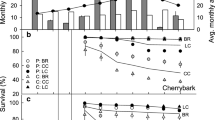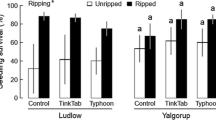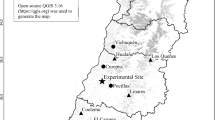Abstract
An improved understanding of important ecophysiological mechanisms underpinning tree water and nutrient use is necessary for developing and testing effective revegetation and restoration techniques in disturbed landscapes. A field trial was established in Central Queensland, Australia, to evaluate tree ecophysiological response to site management methods, including site preparation, herbicide application versus top soil removal (scalping) and fertilisation versus non-fertilisation. The influence of site management practices on plant survival, growth and foliar ecophysiological traits of Acacia disparrima (M. W. McDonald and Maslin) and Eucalyptus crebra (F. Muell.) seedlings was investigated within 22 months following tree planting. There was no difference in the survival of A. disparrima and E. crebra in response to the site preparation. However, there was a significant difference in growth response with both species showing greater mean periodic height gain in the herbicide areas compared to the scalped areas. Plant growth and survival of both species were unaffected by fertilisation, regardless of site preparation treatment. We suggest that the effects of fertiliser may have been masked by drought conditions experienced by seedlings in the first 6 months after planting. Neither site preparation nor fertilisation affected the leaf-level ecophysiological traits of seedlings, including foliar total N, photosynthetic capacity, instantaneous water-use efficiency, carbon isotope composition and stomatal conductance, irrespective of species. Scalping was more effective than herbicide application to suppress weeds and reduced the costs of site preparation and maintenance. Surprisingly, scalping had no impact on plant survival and foliar ecophysiological traits. However, it should be noted that the scalping may not be a sustainable practice in plantation establishment with short rotations where organic matter levels may not have a chance to recover between disturbances.




Similar content being viewed by others

References
Ahemad M, Saghir Khan M (2009) Toxicity assessment of herbicides Quizalafop-p-Ethyl and Clodinafop towards Rhizobium pea symbiosis. Bull Environ Contam Toxicol 82:761–766
Allen CB, Will RE, McGarvey RC, Coyle DR, Coleman MD (2005) Radiation-use efficiency and gas exchange responses to water and nutrient availability in irrigated and fertilized stands of sweet gum and sycamore. Tree Physiol 25:191–200
Barrett-Lennard EG (2002) Restoration of saline land through revegetation. Agri Water Manage 53:213–226
Bird PR, Jowett DW, Jackson TT, Kearney GA, Waters MJ, Measki B (2000) Early growth responses of blue gums on the basaltic plains to ripping, mounding and fertiliser application. Aust J Exp Agric 40:987–994
Choi WJ, Chang SX, Allen HL, Kelting DL, Ro HM (2005) Irrigation and fertilization effects on foliar and soil carbon and nitrogen isotope ratios in a loblolly pine stand. For Ecol Manage 213:90–101
Cole I, Lunt ID, Koen T (2005) Effects of sowing treatment and landscape position on establishment of the perennial tussock grass Themeda triandra (Poaceae) in degraded eucalyptus woodlands in south–eastern Australia. Restor Ecol 13:552–561
Davis MA, Wrage KJ, Reich PB, Tjoelker MG, Schaeffer T, Muermann C (1999) Survival, growth, and photosynthesis of tree seedlings competing with herbaceous vegetation along a water-light-nitrogen gradient. Plant Ecol 145:341–350
Eyles A, Worledge D, Sands P, Ottenschlaeger ML, Paterson SC, Mendham D, O’Grady AP (2012) Ecophysiological responses of a young blue gum (Eucalyptus globulus) plantation to weed control. Tree Physiol 32:1008–1020
Farquhar GD, Richards RA (1984) Isotopic composition of plant carbon correlates with water-use efficiency in wheat genotypes. Aust J Plant Physiol 11:539–552
Farquhar GD, Ehleringer JR, Hubick KT (1989) Carbon isotope discrimination and photosynthesis. Annu Rev Plant Physiol 40:503–537
Flint LE, Childs SW (1987) Effect of shading, mulching and vegetation control on Douglas-Fir seedling growth and soil water supply. For Ecol Manage 18:189–203
Forrester DI, Bauhus J, Cowie AL, Vanclay JK (2006) Mixed-species plantations of Eucalyptus with nitrogen-fixing trees: a review. For Ecol Manage 233:211–230
Forrester DI, Medhurst JL, Wood M, Beadle CL, Valencia JC (2010a) Growth and physiological responses to silviculture for producing solid-wood products from Eucalyptus plantations: an Australian perspective. For Ecol Manage 259:1819–1835
Forrester DI, Theiveyanathan S, Collopy JJ, Marcar NE (2010b) Enhanced water-use efficiency in a mixed Eucalyptus globulus and Acacia mearnsii plantation. For Ecol Manage 259:1761–1770
Forrester DI, Collopy JJ, Beadle CL, Warren CR, Baker TG (2012) Effect of thinning, pruning and nitrogen fertiliser application on transpiration, photosynthesis and water-use efficiency in a young Eucalyptus nitens plantation. For Ecol Manage 266:286–300
George BH, Brennan PD (2002) Herbicides are more cost-effective than alternative weed control methods for increasing early growth of Eucalyptus dunnii and Eucalyptus saligna. N For 24:147–163
Gibbons P, Boak M (2002) The value of paddock trees for regional conservation in an agricultural landscape. Ecol Manage Restor 3:20–210
Graciano C, Guiamét JJ, Goya JF (2005) Impact of nitrogen and phosphorus fertilization on drought responses in Eucalyptus grandis seedlings. For Ecol Manage 212:40–49
Graham S, McGinness HM, O’Connell DA (2009) Effects of management techniques on the establishment of eucalypt seedlings on farmland: a review. Agrofor Syst 77:59–81
Gunter S, Gonzalez P, Alvarez G, Aguirre N, Palomeque X, Haubrich F, Weber M (2009) Determinants for successful reforestation of abandoned pastures in the Andes: soil conditions and vegetation cover. For Ecol Manage 258:81–91
Hobbie EA, Colpaert JV (2004) Nitrogen availability and mycorrhizal colonization influence water-use efficiency and carbon isotope patterns in Pinus sylvestris. N Phytol 164:515–525
Hobbs RJ, Norton DA (1996) Towards a conceptual framework for restoration ecology. Restor Ecol 4:93–110
Hosseini Bai S (2012) The impact of site management practices on the revegetation of highly disturbed sites in sub-tropical and tropical Queensland. PhD Thesis, February 2012. School of Biomolecular and Physical Sciences, Griffith University, Brisbane, Australia
Hosseini Bai S, Blumfield TJ, Xu ZH, Chen C, Wild C (2012) Soil organic matter dynamics and nitrogen availability in response to site preparation and management during revegetation in tropical Central Queensland, Australia. J Soil Sediment 12:386–395
Huang ZQ, Xu ZH, Blumfield TJ, Bubb K (2008a) Effects of mulching on growth, foliar photosynthetic nitrogen and water-use efficiency of hardwood plantations in subtropical Australia. For Ecol Manage 255:3447–3454
Huang ZQ, Xu ZH, Blumfield TJ, Bubb K (2008b) Variations in relative stomatal and biochemical limitations to photosynthesis in a young blackbutt (Eucalyptus pilularis) plantation subjected to different weed control regimes. Tree Physiol 28:997–1005
Ibell PT, Xu ZH, Blumfield TJ (2010) Effects of weed control and fertilization on soil carbon and nutrient pools in an exotic pine plantation of subtropical Australia. J Soil Sediment 10:1027–1038
Ibell PT, Xu ZH, Blumfield TJ (2013) The influence of weed control on foliar δ15 N, δ13C and tree growth in an 8-year-old exotic pine plantation of subtropical Australia. Plant Soil 369:199–217
Khanna PK (1997) Comparison of growth and nutrition of young monocultures and mixed stands of Eucalyptus globulus and Acacia mearnsii. For Ecol Manage 94:105–113
Laganiere J, Angers DA, Pare D (2010) Carbon accumulation in agricultural soils after afforestation: a meta-analysis. Glob Change Biol 16:439–453
Lamb D, Erskine PD, Parrotta JA (2005) Restoration of degraded tropical forest landscapes. Science 310:1628–1632
MacDonald GB, Thompson DJ (2003) Responses of planted conifers and natural hardwood regeneration to harvesting, scalping, and weeding on a boreal mixed wood site. For Ecol Manage 182:213–230
Mallik AU, Hu D (1997) Soil respiration following site preparation treatments in boreal mixed wood forest. For Ecol Manage 97:265–275
Man R, Rice JA, MacDonald GB (2009) Long-term response of planted conifers, natural regeneration, and vegetation to harvesting, scalping, and weeding on a boreal mixed wood site. For Ecol Manage 258:1225–1234
Marcar NE, Hossain AKMA, Crawford DF, Nicholson AT (2000) Evaluation of tree establishment treatments on saline seeps near Wellington and young in New South Wales. Aust J Exp Agric 40:99–106
McDonald PM, Fiddler GO (1993) Feasibility of alternatives to herbicides in young conifer plantations in California. Can J For Res 23:2015–2022
Munger GT, Will RE, Borders BE (2003) Effects of competition control and annual nitrogen fertilization on gas exchange of different-aged Pinus taeda. Can J For Res 33:1076–1083
Orchard KA, Cernusak LA, Hutley LB (2010) Photosynthesis and water-use efficiency of seedlings from northern Australian monsoon forest, savanna and swamp habitats grown in a common garden. Funct Plant Biol 37:1050–1060
Otsamo A, Ådjers G, Hadi TS, Kuusipalo J, Tuomela K, Vuokko R (1995) Effect of site preparation and initial fertilization on the establishment and growth of four plantation tree species used in reforestation of Imperata cylindrica (l.) Beauv. dominated grasslands. For Ecol Manage 73:271–277
Pinkard EA (2003) Growth and physiological responses of Blackwood (Acacia melanoxylon) growing with a Pinus radiata nurse crop following applications of nitrogen and phosphorus. Trees 17:325–335
Prior LD, Eamus D, Duff GA (1997) Seasonal and diurnal patterns of carbon assimilation, stomatal conductance and leaf water potential in Eucalyptus tetrodonta saplings in a wet–dry savanna in Northern Australia. Aust J Bot 45:241–258
Resh SC, Binkley D, Parrotta JA (2002) Greater soil carbon sequestration under nitrogen-fixing trees compared with Eucalyptus species. Ecosystems 5:217–231
Rey Benayas JM, Espigares T, Castro-Dı′ez P (2003) Simulated effects of herb competition on planted Quercus faginea seedlings in Mediterranean abandoned cropland. App Veg Sci 6:213–222
Rey Benayas JM, Navarro J, Espigares T, Nicolau JM, Zavala MA (2005) Effects of artificial shading and weed mowing in reforestation of Mediterranean abandoned cropland with contrasting Quercus species. For Ecol Manage 212:302–314
Richards AE, Forrester DI, Bauhus J, Scherer-Lorenzen M (2010) The influence of mixed tree plantations on the nutrition of individual species: a review. Tree Physiol 30:1192–1208
Rosati A, Esparza G, DeJong TM, Pearcy RW (1999) Influence of canopy light environment and nitrogen availability on leaf photosynthetic characteristics and photosynthetic nitrogen-use efficiency of field-grown nectarine trees. Tree Physiol 19:173–180
Saunders DA, Smith GT, Ingram JA, Forrester RI (2003) Changes in a remnant of salmon gum Eucalyptus salmonophloia and York gum E. loxophleba woodland, 1978–1997. Implications for woodland conservation in the wheat-sheep regions of Australia. Biol Conserv 110:245–256
Scowcroft PG, Friday JB, Idol T, Dudley N, Haraguchi J, Meason D (2007) Growth response of Acacia koa trees to thinning, grass control, and phosphorus fertilization in a secondary forest in Hawaii. For Ecol Manage 239:69–80
Spittlehouse DL, Childs SW (1990) Evaluating the seedling moisture environment after site preparation. In: Gessel SP, Lacate DS, Weetman GF, Powers RF (eds) Sustained productivity of forest soils. Seventh North American Forest Soils Conference. University of British Columbia, Vancouver, B. C., pp 80–94
Subhani A, El-ghamry AM, Changyong H, Jianming X (2000) Effects of pesticides (herbicides) on soil microbial biomass—a review. Pak J Biol Sci 3:705–709
Vitousek PM, Andariese SW, Matson PA, Morris L, Sanford RL (1992) Effects of harvest intensity, site preparation, and herbicide use on soil nitrogen transformations in a young loblolly pine plantation. For Ecol Manage 49:277–292
Wang Y, Fu B, Lü Y, Chen L (2011) Effects of vegetation restoration on soil organic carbon sequestration at multiple scales in semi-arid Loess Plateau, China. Catena 85:58–66
Xu ZH, Saffigna PG, Farquhar GD, Simpson JA, Haines RJ, Walker S, Osborne DO, Guinto D (2000) Carbon isotope discrimination and oxygen isotope composition in clones of the F-1 hybrid between slash pine and Caribbean pine in relation to tree growth, water-use efficiency and foliar nutrient concentration. Tree Physiol 20:1209–1217
Xu ZH, Prasolova N, Lundkvist K, Beadle C, Leaman T (2003) Genetic variation in branchlet carbon and nitrogen isotope composition and nutrient concentration of 11-year-old hoop pine families in relation to tree growth in subtropical Australia. For Ecol Manage 186:359–371
Yildiz O, Sarginci M, Esen D, Cromack JK (2007) Effects of vegetation control on nutrient removal and Fagus orientalis, Lipsky regeneration in the western Black Sea Region of Turkey. For Ecol Manage 240:186–194
Zuazo VHD, Pleguezuelo CRR (2008) Soil-erosion and runoff prevention by plant covers: a review. Agron Sustain Dev 28:65–86
Acknowledgments
This research was supported by Powerlink QLD through the provision of a full-time research scholarship. We thank Ms. Marijke Heenan and Dr. Elizabeth Gordon for their technical supports and Dr. Fangfang Sun, Dr. Lu Shumbao, Dr. Yichao Rui and Mr. Kadum Abdullah for their assistance in the field work. Z. H. X. received the funding support from the Australian Research Council.
Author information
Authors and Affiliations
Corresponding author
Additional information
Communicated by C. Ammer.
Rights and permissions
About this article
Cite this article
Hosseini Bai, S., Blumfield, T.J. & Xu, Z.H. Survival, growth and physiological status of Acacia disparrima and Eucalyptus crebra seedlings with respect to site management practices in Central Queensland, Australia. Eur J Forest Res 133, 165–175 (2014). https://doi.org/10.1007/s10342-013-0755-5
Received:
Revised:
Accepted:
Published:
Issue Date:
DOI: https://doi.org/10.1007/s10342-013-0755-5



